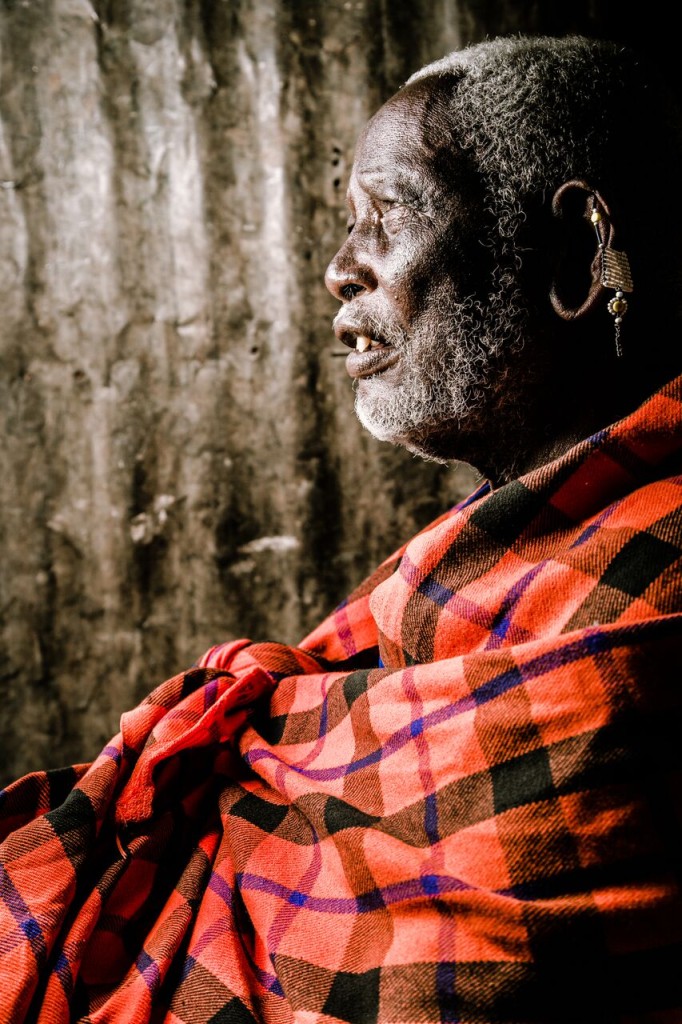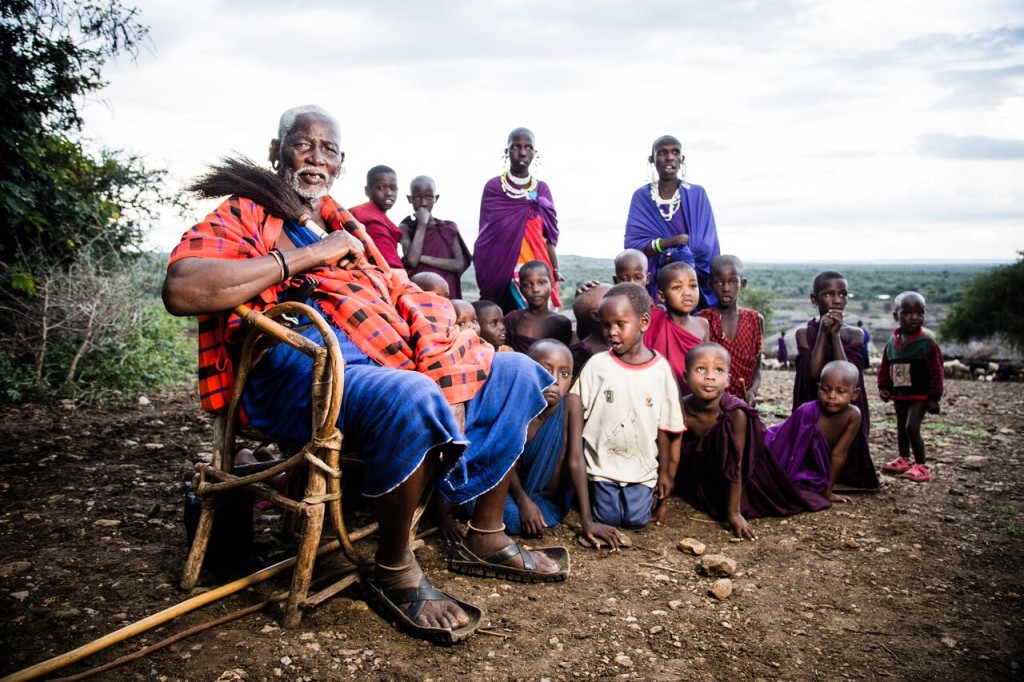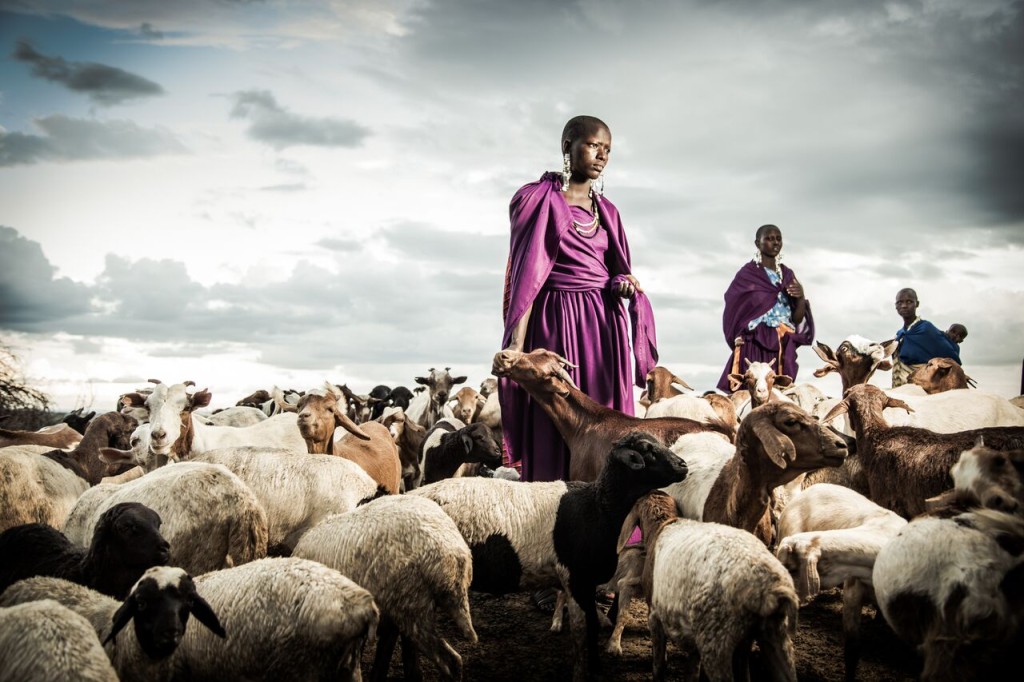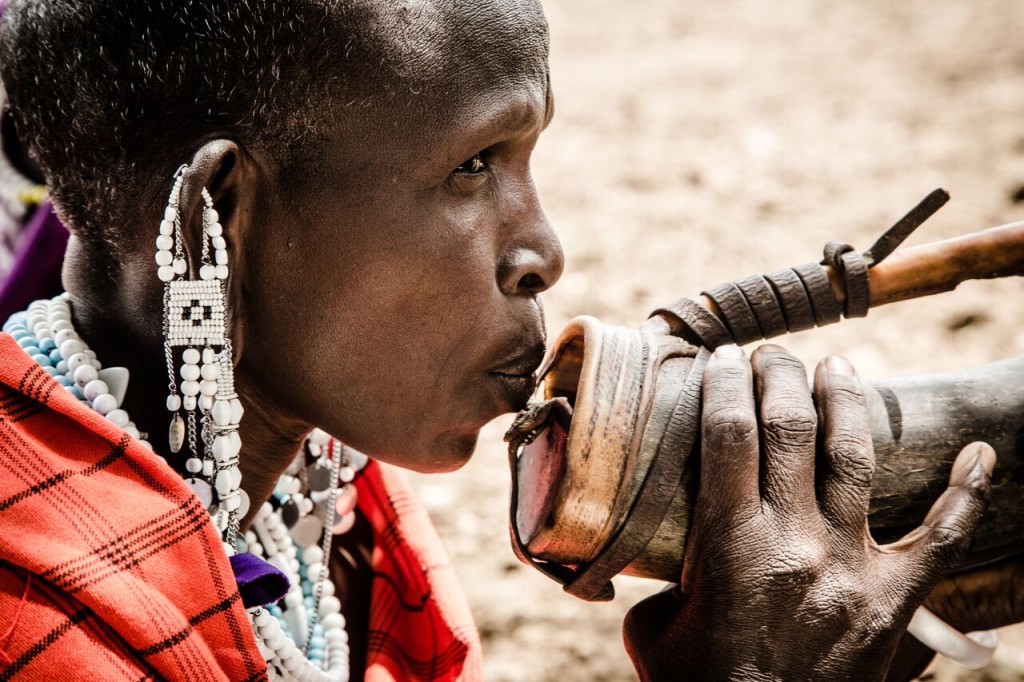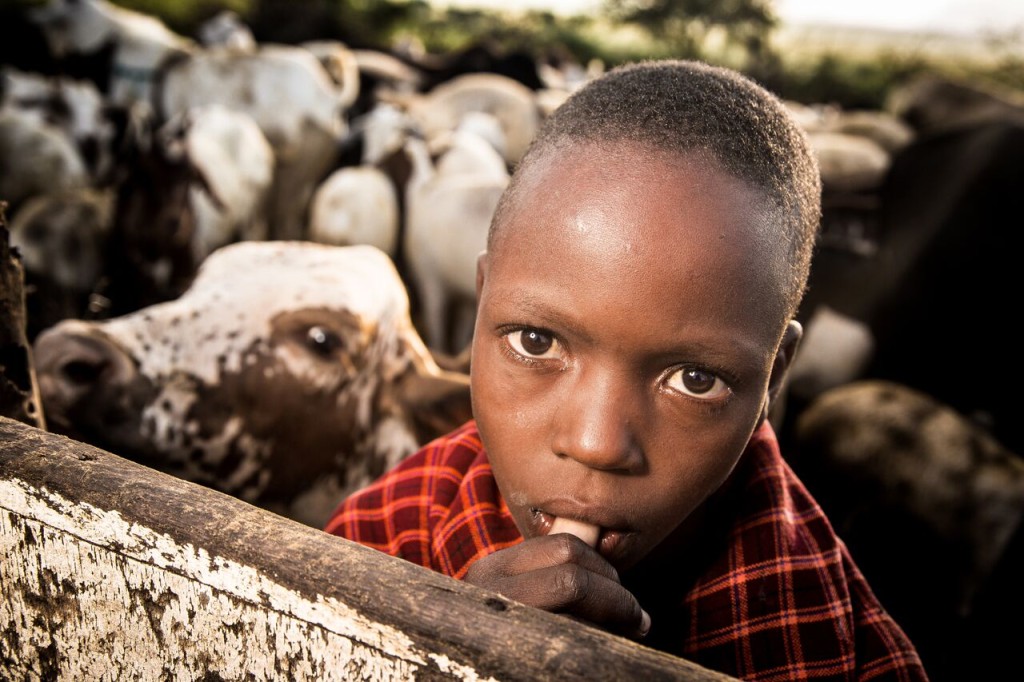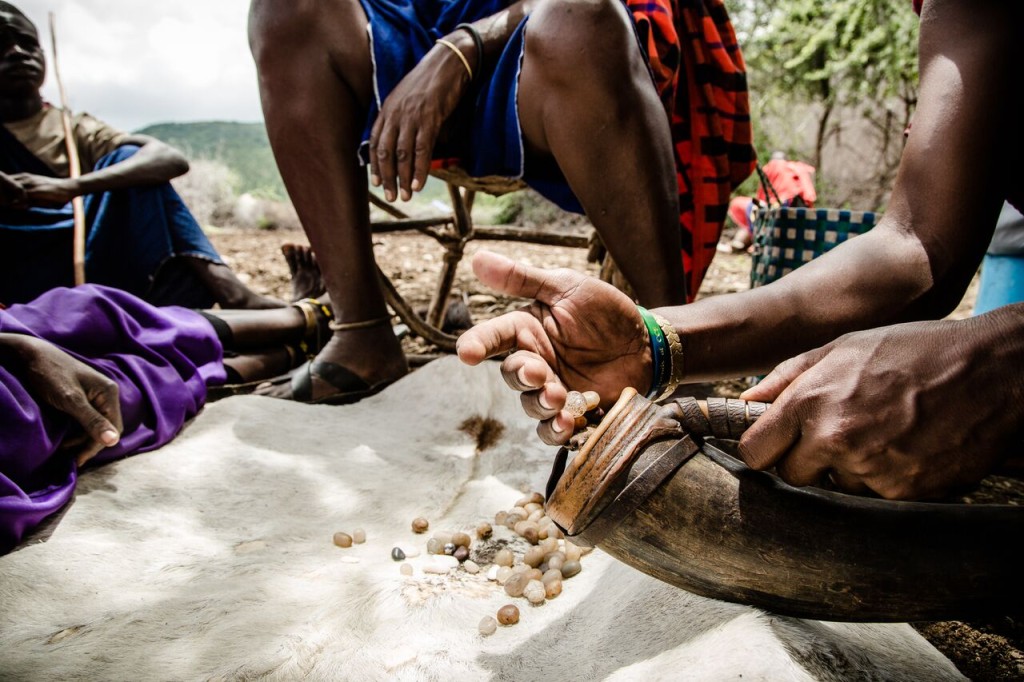Meeting Laibon Meshuko
By Stuart Butler
“I’m one hundred and nine years old”, claimed Meshuko Ole Mapii, who has more children and grand-children than he can name. The old man was sat on a roughly hewn wooden chair. In one hand he held a cow tail fly whisk and in the other an ox horn, plugged at its base with a leather stopper. His short hair was a sparkling silver grey and when he smiled, which he did frequently, one large tooth jutted out of his mouth.
He wore a red shuka (the classic Maasai robe) wrapped like a Roman toga around him. His sandals were made from old truck tyres. He carried with him the air of a man who had seen and done it all and who was certain of his future. That he should have this air of certainty was hardly a surprise. After all, Meshuko is one of the last of the great Maasai Laibon.
Who are the Laibon?
What, I hear you ask, is a Laibon? That’s a little hard to answer. A Laibon is someone of great importance in a traditional Maasai community. They are someone gifted with the power to see the future. They’re not really a fortune teller and they’re certainly not a witch doctor. They’re more like a seer, but some also have the power to cure illnesses. A Laibon is the one who advices the community as a whole on the best course of action to take in a given situation. For example they can use their powers to say where the community’s cattle should be taken to in order to find better grazing when there’s a drought. They are the ones who can pronounce when the time is right for important ceremonies, such as the initiation of a new set of moran (Maasai warriors), to be held and they can also advise an individual in the community on personal matters. Historically there is no more respected member of the Maasai community.
The Role of the Laibon Today
Today though, as Maasai culture changes so the role of the Laibon is becoming reduced and in some areas no more Laibon remain. Therefore, when close to the end of my month long stay at Asilia’s Olivers Camp in Tarangire National Park, I heard from Lazaro, one of the Maasai members of staff, that there was a famous Laibon, named Meshuko, not more than an hours drive from the edge of the national park my interest was instantly piqued and a plan was hatched. I would go and stay the night in Lazaro’s boma (Maasai farmstead) and from there he would take me to meet Meshuko. In the days leading up to my visit I asked any other Maasai I chanced upon what they knew about Meshuko. All replied with the same mixture of amusement that I was going to meet him and awe at the thought of him. He was, it was universally acknowledged, a very powerful man and not just from a spiritual sense. It seemed he also had considerable power in the bedroom… It’s common for important Maasai elders to have a number of wives and many children and over the years I’d frequently interviewed old Maasai men who had been unable to recall the names of all their children (although to be fair to them I seem to be increasingly suffering from this problem as well and I only have two children and one wife), but Meshuko seemed to take the spreading of his genes to new highs. He had, so everyone I spoke with claimed, forty wives and three hundred children. In fact, he had so many children that rather than bother with the expense of paying school fees for each and every one he instead just had a school built in his village, which, so everyone said, was populated only by his children, grand-children and their spouses.
The Chance of a Lifetime
The night before my meeting with the Laibon I’d met Lazaro in the nearest town where we’d stocked up on the gifts he’d said I would need to present to the Laibon: a bag of sugar for his favourite wife and, for the big man himself, twenty or so small plastic sachets of ‘Valeur Superior Brandy’, which as a statement was one I doubted. We’d then ridden together on a motorbike to a wide open plain scattered with brown eyed cattle and the collection of smoky, mud and dung huts that made up Lazaro’s village. As a thunderous rainstorm pelted the sides of the hut we’d sat up late into the night, drinking tea and trading stories, with the dozen or more other villagers who’d piled into the hut to meet the foreign guest. The following morning the sky was once again clear, but a low mist clung to the ground and muffled the sound of the mooing cattle who’d spent the night in the protection of a high fenced corral. As the women busied themselves milking goats and cows, stoking the embers of fires and tending to the children, I sat with the men and drank tea until Lazaro announced that it was time for us to go.
Meshuko’s Village
Set halfway up a low forested hill topped with a red and white radio mast, Meshuko’s village has views across to the flamingo-filled Lake Manyara and is a large and orderly place far more permanent in feel than Lazaro’s village. We found the Laibon sat under the shade of a tree outside the only bricks and mortar building in the village. He was busy treating a thin and quiet lady for “fertility problems” and as we arrived he merely glanced up and nodded a quick hello. Speaking in Maa, the language of the Maasai, Meshuko asked the lady questions and she murmured back short one word replies. As his interrogation into her condition continued he laid out a white goat skin at his feet and started to vigorously shake the ox horn that he held. This, he said, was his ‘oracle’ and when he was satisfied that it had been shaken enough he carefully removed the leather plug and asked the lady to spit into the horn. He then turned it upside down and allowed a stream of small, polished stones (as well as a random ball bearing and some kind of small seed pod) in whites, browns and speckles to fall onto the goat skin. These were then arranged into three neat piles from which the Laibon was able to ‘read’ the ladies future by looking at the patterns of the stones and work out what she needed to do to cure her infertility. As all this was taking place two assistants stood to the side chopping up an orange tinged root vegetable that Meshuko had found in the surrounding forest. This was then pounded into a thick paste using a heavy, dark wood pestle and mortar. This was the medication the lady needed to consume in order to become fertile again. She could either mix it with her food or swill it down like tea in hot water. Either way with what must have been two kilos of the stuff ready for her to consume I didn’t envy her.
As the consultation finished Meshuko turned to me saying how the lady would recover from her problem in a few months and go on to have children. He then invited me into his house so we could talk in peace. It was clear that a person of such importance as Laibon wasn’t born in the same way as the rest of us. So, I wanted to know, where exactly did the first Laibon come from? Every remaining Laibon probably has his own version of this tale, but this one, which has its equivalent in many cultures and religions, is the version Meshuko told.
The First Laibon
The Laibon might be a direct descendent of Enkai (the Maasai God although nowadays Christianity is taking over from Enkai), but life for the first Laibon started in humble ways. One day two Maasai warriors were walking in the forest when they came across a small child. One of the warriors wanted to leave the child. It was after all just a small boy who would likely be a hindrance to them. The other warrior though, who was from the Ilaiser clan (there are seven main Maasai clans plus other sub-clans and the Ilaiser are one of the most powerful clans), picked up the boy and said he was going to take him home and bring him up as his own. The warrior named the boy Kidongoi.
As the years progressed it became clear that this boy had special powers. The cattle he tended were always plump and healthy, even during times of drought when everyone else’s cattle were starving and dying. Other Maasai had even observed him calling into the Heavens for rain and immediately rain would pummel the ground around him and the grass become lush and green. Acknowledging his unusual powers the people made him their spiritual leader or Laibon. Ever since then all Laibon have been from the Ilaiser clan.
A Laibon’s Pebbles
Meshuko paused in his story, stood up, walked slowly to the door of his house, loudly cleared his throat and spat onto the floor. Wiping his mouth he returned to his seat and continued to explain how although the position of Laibon is hereditary a person must still train to be a Laibon. When training begins (normally after the wannabe Laibon has served his time as a moran or warrior) the father, who is himself a Laibon, consults his oracle to identify a suitable ox which the trainee must then negotiate for. The ox is slaughtered and the hide and right-horn shell removed. The father then places his own oracle, pebbles and medicines on the new hide and blesses the hide and the horn. This transforms them into oracles. The trainee heads into the forest to gather any pebbles which take his fancy. They can be unusually shaped ones, pretty ones, perfectly round ones or just plain looking chips of rock. He keeps these inside the ox horn and, as I’d seen earlier, it’s by reading the patterns that these pebbles make when they’re emptied onto the floor that the Laibon makes his divination. However, another Laibon whom I’d once met in Kenya, had told me that not all pebbles can be trusted and as the trainee Laibon becomes more experienced and knowledgeable at divining he might start to notice that there are always one or two pebbles who make false divinations. These pebbles are discarded and replaced with better behaved stones.
Conversation moved onto the moran. Almost every visitor to East Africa will encounter a so-called Maasai moran at some point during their travels, but knowing already that Maasai culture had changed enormously in the past two decades or so and that ‘real genuine’ Moran were now rare, I was curious to hear what Meshuko, who’d been a moran for around twenty years (this will have been a guess as years and the passing of time means little to most older Maasai – as was likely demonstrated when he had told me he was 109 years old) thought of todays moran. He laughed at the question, “When we see these so-called moran, we elders think of them as children. They don’t live in the bush for long. They don’t get to kill many lions. They’re always looking at their telephones and they shave their heads like a woman. When I was a moran men had long hair and women had short hair but now it’s the other way around. They are not real moran anymore”.
I could see that Meshuko was starting to tire and in the breaks in conversation his eyes were becoming heavy and closing for ever longer periods. He was nearly ready for a mid-morning nap and so I asked him one final, personal, question. “Rumour has it that you have forty wives and three hundred children. How many do you really have”? Meshuko sighed. It must have been a question he’d answered a thousand times. “People say this but I don’t. I have a few wives. Eight of them. Each of these wives has about eight, nine or ten children, but I’m too old to remember exactly. When people come here though they see all these children and women but they’re my daughters-in-law and other relations and my grandchildren and great-grandchildren, but people see them all and they go away and say I have three hundred children but this is not true”. Before the interview was complete Meshuko turned the tables on me and asked why I only had one wife and two children. My reply about it just not being necessary to have more children didn’t seem to cut the ice and then Lazaro gave his opinion on why people in the West and urban Africa didn’t have more children, “It’s all to do with the chemicals you put on your foods. You don’t eat fresh foods that you’ve grown yourself like we do and all these chemicals stop you having more children”. It was a good point, and as I thanked Meshuko for his time and left him to sleep, I made a mental note never to buy bio-food again…
Stuart Butler, the author of this piece, has spent the past eighteen months walking and travelling around the Maasai lands of Kenya and Tanzania working on a book about contemporary Maasai culture. Once We Were Lions will be out in 2017 and for more information on it see his website www.walkingwiththemaasai.com and www.stuartbutlerjournalist.com
The post Meeting Laibon Meshuko appeared first on Asilia Africa.
